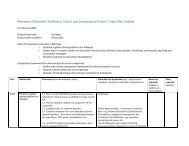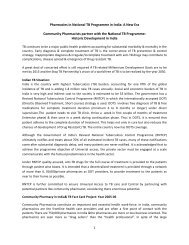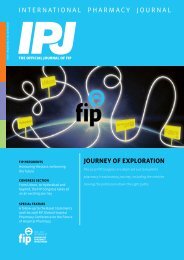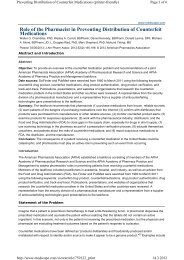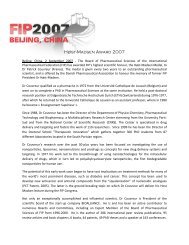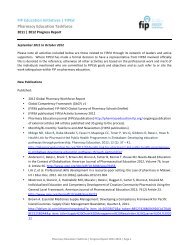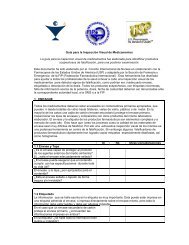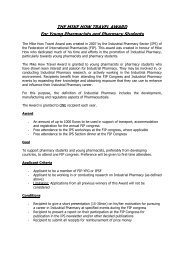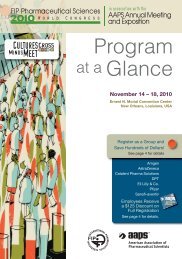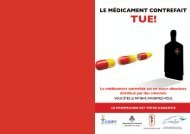Contents - FIP
Contents - FIP
Contents - FIP
Create successful ePaper yourself
Turn your PDF publications into a flip-book with our unique Google optimized e-Paper software.
and material investments are made and informed public health and health service<br />
policies promoted, pharmacy should continue to serve as a global asset capable of<br />
generating progressively increasing health and welfare returns.<br />
Decision makers faced with immediate pressures to reduce spending while extending<br />
access to health services should be aware of the potential for pharmacy as a regulated<br />
business sector and health profession to help resolve health problems in new ways. At<br />
the same time pharmacists and pharmacy related interests must – to not only defend<br />
themselves but arguably more importantly to protect public interests – understand the<br />
continuing need to modernise and go on improving individual and community health<br />
outcomes in changing circumstances.<br />
the origins oF pharmaCy<br />
There is evidence that people have been treating themselves with medicinal substances<br />
for as long as the species Homo sapiens has been in existence. Humans and in all probability<br />
their evolutionary predecessors have for all practical purposes always used plant,<br />
animal and mineral substances as not only foods or food complements but instrumentally<br />
to alleviate distress and cure illnesses.<br />
Within recorded history the roots of pharmacy are said to have been first established<br />
in the world of the ancient Sumarians, who lived in the area that is modern day Iraq<br />
from about 4000 BC. The practitioners of the healing arts of this point in history typically<br />
combined the roles of priests, pharmacists/herbalists and physicians, as indeed do some<br />
shamans and other traditional medicine providers today. Although their approach was<br />
not necessarily scientific in modern terms, there is little doubt of its utility to their communities.<br />
The Sumarians were, for example, aware of the ability of opium to relieve pain.<br />
Similar progress took place in other parts of Asia and Africa at and after that time.<br />
For instance, the early Aryans invaded northern India in around 1500 BC, overwhelming<br />
earlier civilisations such as that of the Indus valley. Ayurveda (literally, the science of life)<br />
initially stemmed from that period, although it was not until over a millennium later<br />
that Acharya Charak produced the Charak(a) Samhita. This early form of a pharmacopeia<br />
remains central to Ayurvedic medicine. It describes the medicinal qualities and uses of in<br />
the order of 100,000 plants and plant derivatives (Vaidya, 2012).<br />
12





